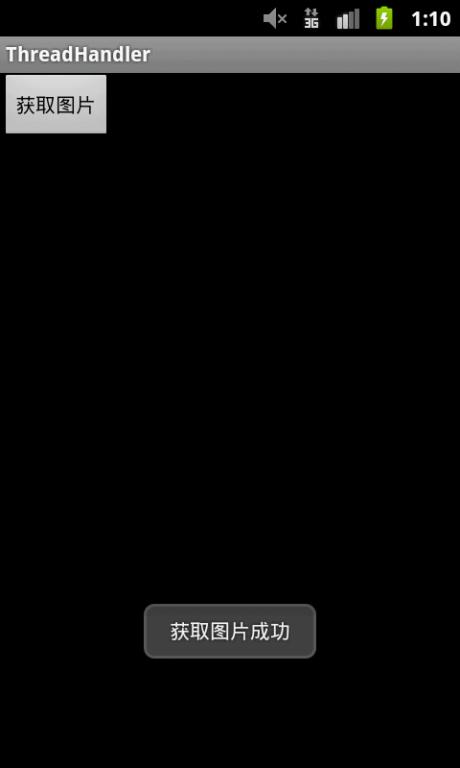标签:
Android异步处理一:使用Thread+Handler实现非UI线程更新UI界面
概述:每个Android应用程序都运行在一个dalvik虚拟机进程中,进程开始的时候会启动一个主线程(MainThread),主线程负责处理和ui相关的事件,因此主线程通常又叫UI线程。而由于Android采用UI单线程模型,所以只能在主线程中对UI元素进行操作。如果在非UI线程直接对UI进行了操作,则会报错:
CalledFromWrongThreadException:only the original thread that created a view hierarchy can touch its views
。
Android为我们提供了消息循环的机制,我们可以利用这个机制来实现线程间的通信。那么,我们就可以在非UI线程发送消息到UI线程,最终让Ui线程来进行ui的操作。
对于运算量较大的操作和IO操作,我们需要新开线程来处理这些繁重的工作,以免阻塞ui线程。
例子:下面我们以获取CSDN logo的例子,演示如何使用Thread+Handler的方式实现在非UI线程发送消息通知UI线程更新界面。
ThradHandlerActivity.java:
public class ThreadHandlerActivity extends Activity { /** Called when the activity is first created. */ private static final int MSG_SUCCESS = 0;//获取图片成功的标识 private static final int MSG_FAILURE = 1;//获取图片失败的标识 private ImageView mImageView; private Button mButton; private Thread mThread; private Handler mHandler = new Handler() { public void handleMessage (Message msg) {//此方法在ui线程运行 switch(msg.what) { case MSG_SUCCESS: mImageView.setImageBitmap((Bitmap) msg.obj);//imageview显示从网络获取到的logo Toast.makeText(getApplication(), getApplication().getString(R.string.get_pic_success), Toast.LENGTH_LONG).show(); break; case MSG_FAILURE: Toast.makeText(getApplication(), getApplication().getString(R.string.get_pic_failure), Toast.LENGTH_LONG).show(); break; } } }; @Override public void onCreate(Bundle savedInstanceState) { super.onCreate(savedInstanceState); setContentView(R.layout.main); mImageView= (ImageView) findViewById(R.id.imageView);//显示图片的ImageView mButton = (Button) findViewById(R.id.button); mButton.setOnClickListener(new OnClickListener() { @Override public void onClick(View v) { if(mThread == null) { mThread = new Thread(runnable); mThread.start();//线程启动 } else { Toast.makeText(getApplication(), getApplication().getString(R.string.thread_started), Toast.LENGTH_LONG).show(); } } }); } Runnable runnable = new Runnable() { @Override public void run() {//run()在新的线程中运行 HttpClient hc = new DefaultHttpClient(); HttpGet hg = new HttpGet("http://csdnimg.cn/www/images/csdnindex_logo.gif");//获取csdn的logo final Bitmap bm; try { HttpResponse hr = hc.execute(hg); bm = BitmapFactory.decodeStream(hr.getEntity().getContent()); } catch (Exception e) { mHandler.obtainMessage(MSG_FAILURE).sendToTarget();//获取图片失败 return; } mHandler.obtainMessage(MSG_SUCCESS,bm).sendToTarget();//获取图片成功,向ui线程发送MSG_SUCCESS标识和bitmap对象 // mImageView.setImageBitmap(bm); //出错!不能在非ui线程操作ui元素 // mImageView.post(new Runnable() {//另外一种更简洁的发送消息给ui线程的方法。 // // @Override // public void run() {//run()方法会在ui线程执行 // mImageView.setImageBitmap(bm); // } // }); } }; }
main.xml布局文件:
<?xml version="1.0" encoding="utf-8"?> <LinearLayout xmlns:android="http://schemas.android.com/apk/res/android" android:orientation="vertical" android:layout_width="fill_parent" android:layout_height="fill_parent"> <Button android:id="@+id/button" android:text="@string/button_name" android:layout_width="wrap_content" android:layout_height="wrap_content"></Button> <ImageView android:id="@+id/imageView" android:layout_height="wrap_content" android:layout_width="wrap_content" /> </LinearLayout>
strings.xml:
<?xml version="1.0" encoding="utf-8"?> <LinearLayout xmlns:android="http://schemas.android.com/apk/res/android" android:orientation="vertical" android:layout_width="fill_parent" android:layout_height="fill_parent"> <Button android:id="@+id/button" android:text="@string/button_name" android:layout_width="wrap_content" android:layout_height="wrap_content"></Button> <ImageView android:id="@+id/imageView" android:layout_height="wrap_content" android:layout_width="wrap_content" /> </LinearLayout>
Manifest.xml:
<?xml version="1.0" encoding="utf-8"?>
<manifest xmlns:android="http://schemas.android.com/apk/res/android"
package="com.zhuozhuo"
android:versionCode="1"
android:versionName="1.0">
<uses-sdk android:minSdkVersion="9" />
<uses-permission android:name="android.permission.INTERNET"></uses-permission><!--不要忘记设置网络访问权限-->
<application android:icon="@drawable/icon" android:label="@string/app_name">
<activity android:name=".ThreadHandlerActivity"
android:label="@string/app_name">
<intent-filter>
<action android:name="android.intent.action.MAIN" />
<category android:name="android.intent.category.LAUNCHER" />
</intent-filter>
</activity>
</application>
</manifest>
运行结果:

为了不阻塞ui线程,我们使用mThread从网络获取了CSDN的LOGO
,并用bitmap对象存储了这个Logo的像素信息。
此时,如果在这个线程的run()方法中调用
mImageView.setImageBitmap(bm)
会出现:CalledFromWrongThreadException:only the original thread that created a view hierarchy can touch its views。原因是run()方法是在新开的线程中执行的,我们上面提到不能直接在非ui线程中操作ui元素。
非UI线程发送消息到UI线程分为两个步骤
一、发送消息到UI线程的消息队列
通过使用Handler的
Message obtainMessage(int what,Object object)
构造一个Message对象,这个对象存储了是否成功获取图片的标识what和bitmap对象,然后通过message.sendToTarget()方法把这条message放到消息队列中去。
二、处理发送到UI线程的消息
在ui线程中,我们覆盖了handler的
public void handleMessage (Message msg)
这个方法是处理分发给ui线程的消息,判断msg.what的值可以知道mThread是否成功获取图片,如果图片成功获取,那么可以通过msg.obj获取到这个对象。
最后,我们通过
mImageView.setImageBitmap((Bitmap) msg.obj);
设置ImageView的bitmap对象,完成UI的更新。
补充:
事实上,我们还可以调用
View的post方法来更新ui
mImageView.post(new Runnable() {//另外一种更简洁的发送消息给ui线程的方法。 @Override public void run() {//run()方法会在ui线程执行 mImageView.setImageBitmap(bm); } });
这种方法会把Runnable对象发送到消息队列,ui线程接收到消息后会执行这个runnable对象。
从例子中我们可以看到handler既有发送消息和处理消息的作用,会误以为handler实现了消息循环和消息分发,其实Android为了让我们的代码看起来更加简洁,与UI线程的交互只需要使用在UI线程创建的handler对象就可以了。如需深入学习,了解消息循环机制的具体实现,请关注《Android异步处理三:Handler+Looper+MessageQueue深入详解》
工程打包下载:http://www.androidtwitters.com/blog/threadhandler.rar
本博文地址:http://blog.csdn.net/mylzc/article/details/6736988 转载请注明出处
标签:
原文地址:http://www.cnblogs.com/mumue/p/4186628.html